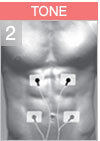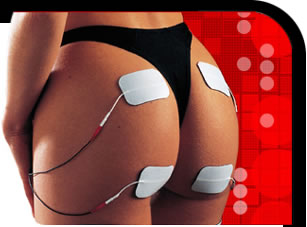What is muscle electrostimulation
Muscle electrostimulation is a physiotherapy technique That, via a special device, sends electrical impulses to stimulate muscle contractions. Created for physiotherapy and rehabilitation purposes, over time it has also been used in the sporting and aesthetic fields.
In the sporting field the muscle electrostimulators they are used for muscle recovery and training while in the aesthetic field as an aid in lymphatic drainage treatments and in general for fat reduction
In the aesthetic sector it is suitable for the treatment of some blemishes of the skin, such as the cellulite, water retention, stretch marks, due to loss of muscle tone and elasticity, or even the stagnation of liquids caused by surgery or venous insufficiency
Types of electrostimulation: TENS, EMS, interferenziale
For there are three types of electrostimulation used for pain treatment and rehabilitation:
- TENS electrostimulation, which acts directly on nerve fibers that have a large diameter and, through impulses, increases the release of endorphins which in turn positively affects the perception of pain, diminishing it;
- EMS electrostimulation, which exploits low intensity microcurrents. It is particularly suitable for reducing pain, both chronic and acute, resulting from minor injuries; very often, especially in the sporting field, it is associated with TENS electrostimulation to obtain greater benefits; Furthermore, thanks to training with EMS it is possible to increase resistance, speed or strength particularly in the abdominal areas, quadriceps and legs.
- interferential electrostimulation, which is generated at the meeting point of two medium frequency currents. It is very useful for relieving pain caused by deep muscle hypotrophy, hip arthritis, deep tendinopathies and lumbar spine thanks to the dual excitomotor action, stimulating the innervated muscles and favors the reduction of swelling, and antalgic, can reduce pain.
Depending on the intended use, electrostimulation then has a further classification depending on the frequency that can be:
- continuous electrostimulation, that is, when there are no variations in frequency rhythms and it is particularly suitable for warming up and recovery. Low frequency electrical pulses are usually used;
- intermittent electrostimulation, indicated for the duration of the training, alternating the frequency in the phase in which the muscles contract (so-called work phase) and in the one in which they rest (cool-down phase);
- frequency modulated electrostimulation, which takes the form of varying the frequency during the work phase to intensify the strength;
- amplitude modulation electrostimulation, which makes the duration of the pulse variable in the work phase.
Benefits of muscle electrostimulation
The stimulators they are able to improve muscle tone following immobilization of the limb and to stimulate the denervated muscle. Using TENS electrotherapy (Transcutaneous Electrical Nerve Stimulation), thanks to high voltage pulses, painful conditions are treated in such a way as to have a great analgesic effect.
In the aesthetic field however, the benefits ofelectrostimulator consist of firming and in the improvement of skin blemishes. By burning fat you obtain greater muscle tone and fluid drainage.
 Finally, in the sporting field, electrostimulation allows faster muscle recovery from an injury and strengthening of the muscles in preparation for competitive activity.
Finally, in the sporting field, electrostimulation allows faster muscle recovery from an injury and strengthening of the muscles in preparation for competitive activity.
Contraindications
We do not recommend the use of electrostimulators in the following cases:
- Stimulation of the front of the neck (carotid sinus).
- Patient with pace maker.
- Cancer patients (consult your oncologist).
- Stimulation of the brain region.
- Use on pain whose etiology is unknown.
- Sores and dermatological diseases.
- Acute trauma.
- Stimulation on recent scars.
- Pregnancy.
- The use of the electrostimulator in the ocular and genital area is absolutely prohibited.
- Using the electrostimulator in water
- In the vicinity of areas to be treated characterized by the presence of metallic synthesis media and intra-tissue metals (as prosthetics, osteosynthesis materials, spiral, viti, plaques), if monophasic currents such as interferential and direct current are used (ionoforesi).

